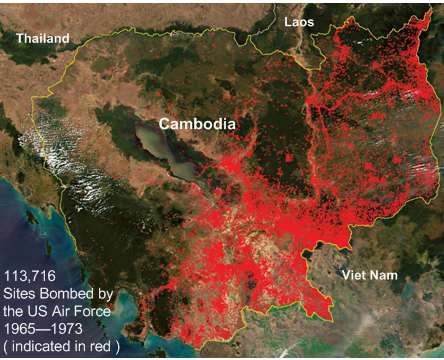Cambodia 1973

Sites in Cambodia bombed by the U.S. Air Force
In two of Indochina's three countries it was possible to reduce the number of U.S. (in Vietnam ) and proxy (in Laos ) troops while working out a negotiated agreement with the enemy. In Cambodia , though, the situation was different. A negotiated settlement was not arrived at: on the one hand, the Khmer Rouge resisted North Vietnamese pressure for a cease-fire; on the other hand, although, at U.S. urging, Lon Nol duly offered a cease fire, what he proposed was extremely one-sided. The war thus continued, with the U.S. resorting to the increasingly heavy bombing strikes described elsewhere on this site. This policy led to an even stronger reaction than was induced when Nixon merely spoke of bombing in Vietnam: newspapers and members of Congress forcefully questioned both the legality and the reasonableness of continuing to bomb Cambodia when the U.S. no longer had ground troops fighting anywhere in the region (and thus could no longer make the argument that the bombing helped protect the troops). By May, even Republicans and conservative Democrats were revolting, and the House of Representatives voted to cut off funds for all combat activities in Cambodia after 30 June. The Senate, for good measure, amended the measure to cover Laos as well; and then both houses of Congress broadened the legislation still further to cover North and South Vietnam . Although he vetoed this bill, Nixon knew that the game was up, and he reluctantly agreed to a measure which banned all U.S. combat operations in Indochina starting on 15 August. There was, as we saw in the other Cambodia writeup, a final paroxysm of bombing in June, July, and August, and that was the end: from then on, Cambodia would only receive military and economic aid. 1
1) Shawcross (1979: chs. 18-9); Bundy (1998: 365-78, 383-94); Clymer (2004: 59-85).
